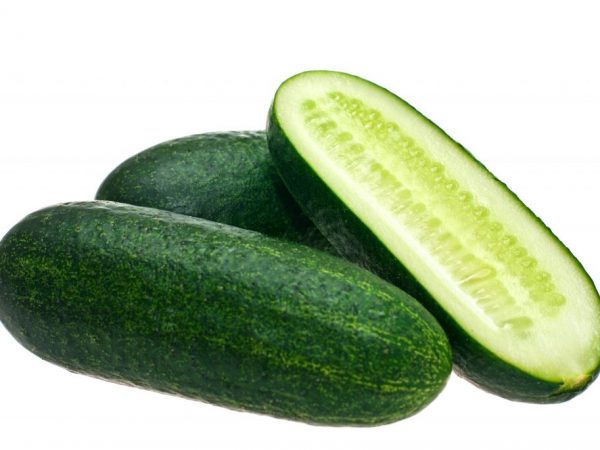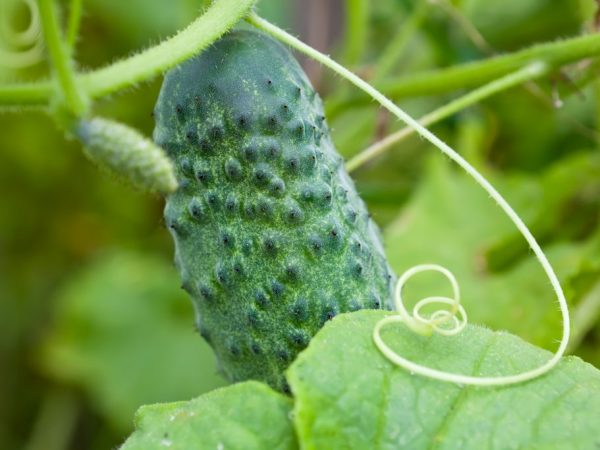Characteristics of Lukhovitsky cucumbers
Lukhovitsky cucumbers are a whole family of cucumbers, which includes several varieties. All vegetables differ in characteristics from each other and require adherence to the rules of care.

Characteristics of Lukhovitsky cucumbers
Benefits
Early vegetables have been grown in Lukhovitsy since the 1930s. Among their advantages are noted:
- great taste: fruits are sweetish (without a hint of bitterness), juicy, with a fresh cucumber smell;
- the same sizes of zelents: they have a regular cylindrical shape, up to 12 cm in length;
- excellent commercial qualities: dense, crispy pulp without voids, the possibility of long-term storage and transportation;
- high productivity;
- versatility of use: cucumbers are suitable both for fresh consumption and for the preparation of canned vegetables, pickles;
- resistance to many diseases of pumpkin crops.
The catalog of varieties and hybrids belonging to the Lukhovitsky cucumber group does not remain unchanged. The gardeners of the region cooperate with breeders, introduce new varieties into circulation.
Description of varieties and hybrids
Lukhovitsky cucumber has a different origin: among those grown there are varieties and hybrids of both domestic and Dutch selection. Since the 60s. of the last century, the Vyaznikovsky and Murom varieties are popular, since the 1970s - the Graceful variety, decades later they began to grow Libella and Mirinda, at the beginning of the new century - Othello, and in recent years the Dutch hybrids Solinas and Adam have become local.
Brief characteristics of the varieties of Lukhovitsky cucumbers:
- Vyaznikovsky - a plant with short lashes and bundle ovaries; fruits are ovoid, 9-11 cm long, with small tubercles; the variety is resistant to many diseases and temperature extremes; growing, easy care is primitive.
- Muromsky forms lashes of medium length (up to 1.6 m); greens 10-14 cm, small lumpy, have a traditional sweetish taste in the complete absence of bitterness; the variety does not suffer from bacteriosis and powdery mildew.
- Graceful has a description of the bush and the size of the greenery similar to the Muromsky one, only the shape of the fruit differs - it is elliptical; the variety has an average yield (5-7 kg per 1 sq. m), resistant to olive spot.
- Libella and Mirinda are medium-growing varieties with side shoots and a large number of ovaries, which is a prerequisite for yield; zelentsy have an average mass of 100 g, cylindrical shape, no more than 12 cm; immune to fungal diseases.
- Adam F1 is a Dutch hybrid characterized by vigorous vines and a female type of flowering, the yield is good - 8-10 kg per sq. m; small cucumbers (11-12 cm), cylindrical, tuberous, with a small fluff;
- Solinas F1 - high-yielding Dutchman with vigorous shoots and bunchy blooms; miniature greens (no more than 9 cm), with small tubercles; like the previous hybrid, they are resistant to powdery mildew, the mosaic virus.
Not all varieties of crops meet the requirements of vegetable growers from Lukhovitsa.For example, cucumber Lukhovitskiy F1, according to agronomists, did not become widespread in the region due to later ripening periods and a large number of deformed zelents.
Growing features

The first cucumbers are harvested in May

According to the description, the cultivation of varieties of Lukhovitsky cucumbers is carried out according to the technology formed over many decades of the existence of the cucumber industry in the Moscow region. The first collection of zelents is carried out in mid-May, thanks to the greenhouses with a multilayer coating.
Landing
The vegetable beds and cucumber seeds are prepared in the fall: they dig up, fertilize the soil with manure and humus, and process the seed. Particular care is the removal of plant debris from the ground that can become a source of disease.
The seeds are sown at the end of March in homemade peat cubes, which are placed in a small area under several layers of film. In cold weather, cover the film on top with canvas bags.
They are transplanted into open ground around mid-April. The beds are usually prepared 1 m wide. They are covered with plastic wrap with slots every 40 cm. Seedlings that have formed at least one true leaf are placed in these slots.
Young plants are watered with warm water and covered with a film fixed on arcs 60-80 cm high. A second layer is placed on top of the first layer, resting on meter arcs. The resulting air gap retains heat and moisture well from the sun.
Care
In the first weeks after planting the seedlings, watering is not required. With the onset of hot weather, watered with warm, settled water. Watering is carried out in the evening, water should not fall on the leaf plate. With the formation of the first fruits, the plants need more moisture, therefore, more intensive watering is carried out.
The film shelter is opened during the day to ventilate the greenhouse and remove excess vapors. In rainy weather, when the temperature drops, the planting is left covered or opened for a short time, because high humidity favors the spread of pathogenic fungi.
Plants are fed with complex mineral fertilizers with the addition of organic matter.
Timely collection of zelents stimulates the formation of ovaries, so you need to pick cucumbers every other day or every day if you need fruits at the pickle stage (4-5 cm).
The described growing rules were developed precisely in Lukhovitsy, but the varieties mentioned above can be grown wherever it is possible to create the necessary conditions for the growth of the culture. The most important points:
- fertile soil, loose and moist;
- air temperature not lower than 15 ° С;
- wind protection and good illumination.
Warm beds
Lukhovitsky cucumbers are a thermophilic culture. You can get an early harvest thanks to the arrangement of insulated beds. For this, manure (cow or horse) is prepared: it is compacted, sprinkled with earth and covered with a film to protect it from freezing. In early spring, the shelter is removed, the manure is mixed with the ground. Such soil becomes loose and warms up faster due to the vigorous activity of microorganisms.
To prepare an insulated bed, a recess is pulled out up to 40 cm, after which they are laid in layers:
- sawdust with the addition of urea (10-12 cm);
- manure, it is possible with the addition of plant organics (rotted leaves, grass);
- ground (20-25 cm).
Using this technology, you can grow vegetables in the open field. Early landing will require temporary cover. In Central Russia, areas with a colder climate, Lukhovitsky cucumber is grown in greenhouses.
Conclusion
Despite the fact that Lukhovitsky cucumbers require special care and adherence to the rules of watering and feeding, the fruits of the plant are more than worth the time spent on them during the growing period. Lukhovitsky cucumbers are grown in different regions. The main thing is to properly prepare the soil, plant seeds and follow the rules of care.


